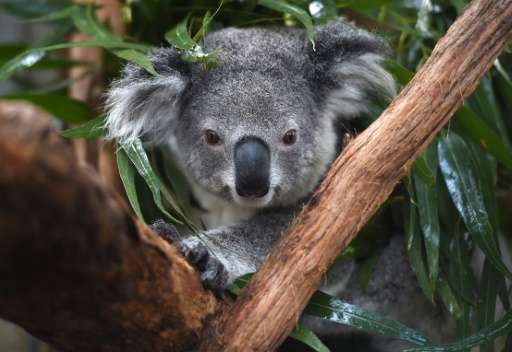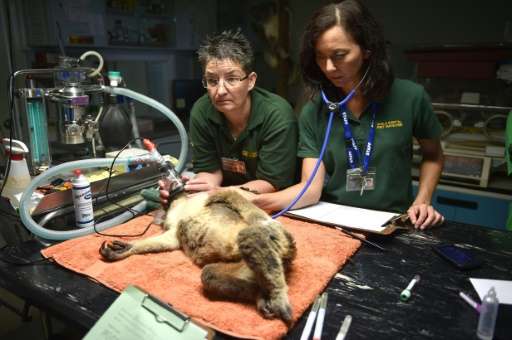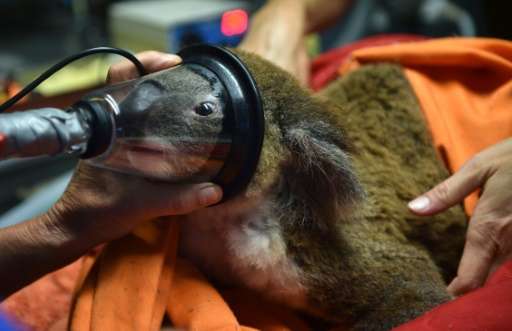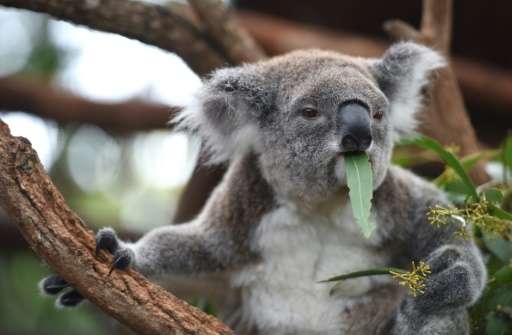Hairy future for Australia's beloved koala

A sweet, sickly smell filled the air as Sherwood Robyn, a 12-year-old koala, was brought into a small examination room at Australia's first hospital for the furry marsupials.
From afar, she appeared in fine health. But closer inspection revealed a "wet bottom"—a clear sign of the chlamydia infection which is ravaging Australia's iconic native animal.
With no available cure, Robyn, found on Sherwood Road and named in a nod to the famous outlaw, is already experiencing advanced stages of the sexually-transmitted disease and will likely die a painful death within months, vets say.
The spread and impact of the disease have been exacerbated by human development encroaching the animals' territory, Cheyne Flanagan, clinical director at the Koala Hospital in Port Macquarie, told AFP.
"It's driven by pressure on the animals, when there's a disturbed habitat... they're forced to live closer together, which gives us more interaction between the animals," she explained.
This causes the disease to spread rapidly, Flanagan added, saying that additional factors such as increased competition for territory and food can add to the problem.
The prognosis for Sherwood Robyn mirrors the dire outlook for koala populations on Australia's east coast as habitat loss, dog attacks, car strikes, climate change and disease take their toll.

While there were believed to be more than 10 million koalas before British settlers arrived in 1788, a 2012 national count placed their total numbers at around 330,000, though their existence in treetops makes accurate assessment difficult.
In parts of Queensland, koalas are "effectively extinct" a recent study by the state university found. In New South Wales the marsupial's overall numbers have plunged more than 30 percent since 1990. Both regions—along with the Australian Capital Territory—have listed the animal as "vulnerable" to extinction.
"I'm not optimistic at all," said Damien Higgins, head of the Koala Health Hub at the University of Sydney, assessing the animal's long term prospects for survival.
"Ultimately, the pressures acting against koalas are not going away. Development is continuing... and while people want to live where koalas live... and mine where koalas live, they're going to be in trouble," he told AFP.
Chlamydia has been in koala populations for some time and can cause blindness, infertility and death. It is different to the human strain of the disease: The latest research suggests it could have first spread to the marsupials from livestock brought by early European settlers to Australia.
But increased human development on koala territory has exacerbated the impact of the disease in recent years.

'Death by a thousand cuts'
The Koala Hospital was established in the coastal town of Port Macquarie in 1973. But there has been a marked shift in those being treated in recent years.
Flanagan says she now sees mainly older marsupials and that admission numbers have dramatically fallen—suggesting populations are dying out.
She believes the changes are caused by habitat loss as trees are felled to make way for urban development, describing the impact on koalas as "death by a thousand cuts".
Due to this land clearance, young koalas are driven further afield to search out suitable sites to set up home, making them vulnerable to vehicle strikes and animal attacks, said hospital coordinator Mick Feeney.
The animal famously only eat leaves from a narrow range of the eucalyptus gum tree species—limiting its food supply and adding to its woes.

"It's not an easy issue to deal with in an area where there is a great deal of growth," Port Macquarie-Hastings Mayor Peter Besseling told AFP.
"People want to move to the coast and we need to look at ways in which we can protect the koala into the long-term," he added.
Researchers at the University of Sydney, who have collaborated closely with the Koala Hospital for decades, are working hard to mitigate the challenges facing koalas by studying the diseases they succumb to.
"The other aspect is damage control. Once things like development are happening, (it's about) trying to somehow reduce the impact on koalas," Higgins said.
"It's a band-aid in a way, to try and keep the populations as healthy as we can."
© 2016 AFP




















